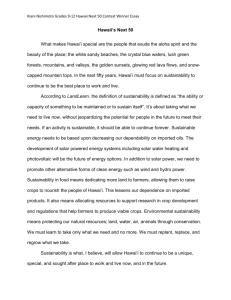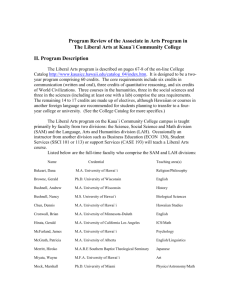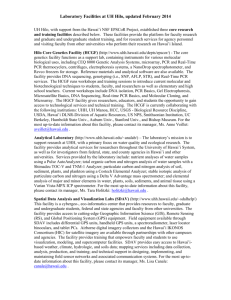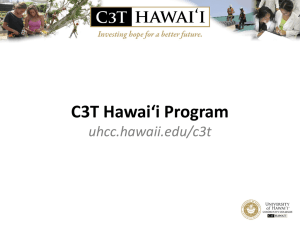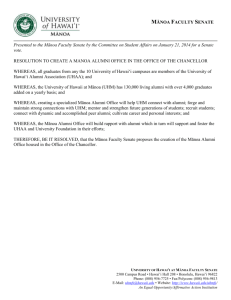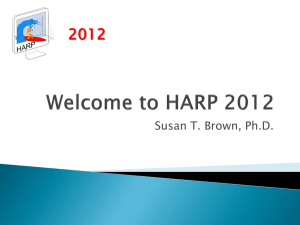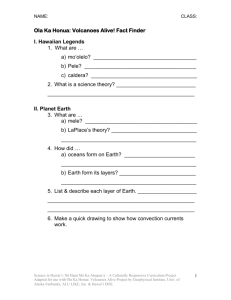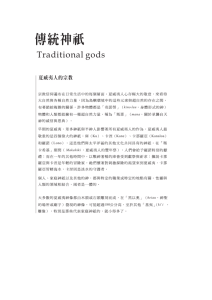2011 Strategic Planning Process
advertisement
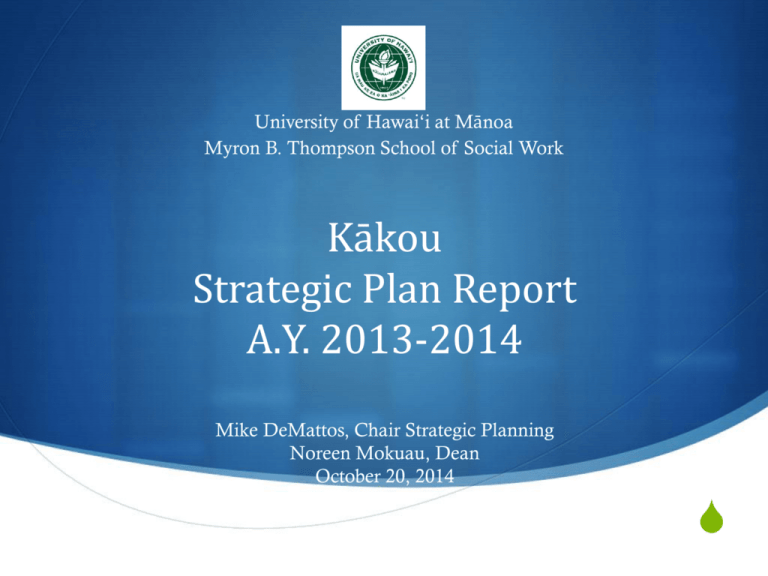
University of Hawai‘i at Mānoa Myron B. Thompson School of Social Work Kākou Strategic Plan Report A.Y. 2013-2014 Mike DeMattos, Chair Strategic Planning Noreen Mokuau, Dean October 20, 2014 S University of Hawai‘i System Strategic Plan Entering the University’s Second Century, 2002-2010 S University of Hawai‘i System Strategic Plan Entering the University’s Second Century, 2002-2010 System Mission The common purpose of the University of Hawaii system of institutions is to serve the public by creating, preserving, and transmitting knowledge in a multi-cultural environment. The University is positioned to take advantage of Hawaii’s unique location, physical and biological environment, and rich cultural setting. At all levels in the academy, students and teachers engage in the mastery and discovery of knowledge to advance the values and goals of a democratic society and ensure the survival of present and future generations with improvement in the quality of life. University of Hawai‘i System Strategic Plan Entering the University’s Second Century, 2002-2010 Purposes of the University of Hawai‘i S Provide all qualified people in Hawaii with equal opportunity for high quality college and university education and training. S Provide a variety of entry points into a comprehensive set of postsecondary educational offerings, allowing flexibility for students to move within the system to meet individual educational and professional goals. S Advance missions that promote distinctive pathways to excellence, differentially emphasizing instruction, research, and service while fostering a cohesive response to state needs and participation in the global community. University of Hawai‘i System Strategic Plan Entering the University’s Second Century, 2002-2010 Core Values S Aloha S Diversity, fairness, and equity S Collaboration and respect S Leveraged technology S Academic freedom and intellectual rigor S Hawaiian and Asian-Pacific advantage S Institutional integrity and service S Innovation and empowerment S Access, affordability, and excellence S Accountability and fiscal integrity S Active learning and discovery S Malama aina sustainability University of Hawai‘i System Strategic Plan Entering the University’s Second Century, 2002-2010 System Goals and Objectives S Goal 1: Educational Effectiveness and Student Success S Objective 1: To achieve a shared institutional culture that makes student learning and success the responsibility of all S Objective 2: To achieve a shared institutional culture that treasures diversity and inclusion, honors collegiality, and continuously strives for exceptional performance University of Hawai‘i System Strategic Plan Entering the University’s Second Century, 2002-2010 System Goals and Objectives S Goal 2: A Learning, Research, and Service Network S Objective 1: To excel in basic and applied research for the discovery and dissemination of new knowledge S Objective 2: To support Hawaii’s economy, workforce development, and improved access and flow of education in Hawaii from preschool through a lifetime of learning by building partnerships within the University and with other public and private educational, governmental, and business institutions S Objective 3: To provide access for students, faculty, and staff to a first-class information technology infrastructure, support, and services that sustain and enhance University instruction, research, and administrative services within the University, throughout Hawaii, and beyond University of Hawai‘i System Strategic Plan Entering the University’s Second Century, 2002-2010 System Goals and Objectives S Goal 3: A Model Local, Regional, and Global University S Objective 1: To establish the University of Hawaii and the state of Hawaii as the research, service, and training hub of Oceania, with bridges to the Asia-Pacific region, the Americas, and the rest of the world S Objective 2: To strengthen the crucial role that the University of Hawaii system performs for the indigenous people and general population of Hawaii by actively preserving and perpetuating Hawaiian culture, language, and values. University of Hawai‘i System Strategic Plan Entering the University’s Second Century, 2002-2010 System Goals and Objectives S Goal 4: Investment in Faculty, Staff, Students, and Their Environment S Objective 1: To create a University culture of excellence by recruiting, rewarding, and empowering top-performing faculty and staff and to foster a spirit of joint enterprise and appreciation for all University employees, including graduate assistants and student employees S Objective 2: To create positive, healthful, resource efficient, and sustainable physical environments on the campuses of the University that enhance the psychological well-being of the students, employees, and community members University of Hawai‘i System Strategic Plan Entering the University’s Second Century, 2002-2010 System Goals and Objectives S Goal 5: Resources and Stewardship S Objective 1: To build an effective constituency that converts community support for the University of Hawaii into public and private revenue streams that support achievement of strategic plan goals S Objective 2: To allocate and manage resources to achieve continuing improvement in organization, people, and processes and to secure competitive advantage University of Hawai‘i System Strategic Plan Performance Measures 2008-2015 S University of Hawai‘i System Strategic Plan Performance Measures, 2008-2015 S Native Hawaiian Education Attainment - To position the University of Hawai‘i as one of the world’s foremost indigenous-serving universities by supporting the access and success of Native Hawaiians. S Hawai‘i’s Educational Capital - To increase the educational capital of the state by increasing the participation and completion of students, particularly Native Hawaiians, lowincome students, and those from underserved regions. S Economic Contribution - To contribute to the state’s economy and provide a solid return on its investment in higher education through research and training. S Globally Competitive Workforce - To address critical workforce shortages and prepare students (undergraduate, graduate, and professional) for effective engagement and leadership in a global environment. S Resources and Stewardship - To acquire, allocate, and manage public and private revenue streams and exercise exemplary stewardship over all of the University’s resources for a sustainable future. Achieving our Destiny The University of Hawai‘i at Mānoa Strategic Plan 2011-2015 S Achieving our Destiny The University of Hawai‘i at Mānoa Strategic Plan 2011-2015 UHM Vision The University of Hawai‘i at Mānoa will gain international recognition as among the nation’s leading land, sea, and space grant universities Grounded in the traditional values of our host culture, we strive for excellence in teaching, research, and community engagement, while promoting environmental sustainability and human justice Achieving our Destiny The University of Hawai‘i at Mānoa Strategic Plan 2011-2015 UHM Mission As a land, sea, and space grant university, the University of Hawai‘i at Mānoa is dedicated not only to academic and research excellence but also to serving with aloha the local, national, and international communities that surround us Taking as its historic trust the Native Hawaiian values embedded in the concepts of kuleana, ‘ohana, and ahupua‘a that serve to remind us of our responsibilities to family, community, and the environment, Mānoa’s hallmark is a culture of community engagement that extends far beyond the classroom to bridge theory and practice, fostering creative and critical thinking, and promoting students’ intellectual growth and success as contributing members of society. Central to this mission is faculty dedication to a fertile, engaged, and ethical learning environment characterized by a free exchange of ideas, shared intellectual resources, cutting edge scholarship, and high academic expectations With its unique geographic location bridging East and West, Mānoa serves as a portal to an exceptional educational experience while striving to improve quality of life in the region through collaborative partnerships that support innovations in education, health care, social development, culture and arts, earth, space, and ocean sciences, sustainable agriculture and land management, and technological advancement Achieving our Destiny The University of Hawai‘i at Mānoa Strategic Plan 2011-2015 UHM AOD Goals S A Transformative Teaching and Learning Environment S A Global, Leading Research University S An Engaged University S Facilitating Excellence Achieving our Destiny The University of Hawai‘i at Mānoa Strategic Plan 2011-2015 A Transformative Teaching and Learning Environment S Increase experiential learning opportunities across the curriculum S Expand and create transdisciplinary opportunities and programs S Increase student success S Expand international study opportunities S Promote a Hawaiian Place of Learning S Ensure that quality of teaching is as important as quality of research in hiring, tenure and promotion Achieving our Destiny The University of Hawai‘i at Mānoa Strategic Plan 2011-2015 A Global, Leading Research University S Promote faculty and student research and scholarship S Reward and support outstanding faculty, staff, and students S Improve research infrastructure S Invest in key areas of research and scholarship Achieving our Destiny The University of Hawai‘i at Mānoa Strategic Plan 2011-2015 An Engaged University S Promote scholarly work that informs policies and practices that S S S S benefit communities Expand internships, practica, mentoring, and service learning Increase partnerships and sharing of expertise with community organizations Increase appreciation and understanding of cultural expression in Hawai‘i and the Asia-Pacific Rim Facilitate student leadership and involvement in campus governance Achieving our Destiny The University of Hawai‘i at Mānoa Strategic Plan 2011-2015 Facilitating Excellence S Implement sustainable management practices in the use of energy, S S S S water, paper and other resources Improve facilities management systems to foster community engagement and student learning Streamline business processes and invest in technology to promote data- driven decision-making Increase transparency, efficiency and accountability in resource allocation policies and practices Implement processes to promote a Hawaiian Sense of Place Kākou MBTSSW Strategic Plan Report A.Y. 2013-2014 S Kākou MBTSSW Strategic Plan Report A.Y. 2013-2014 Mission The mission of the Myron B. Thompson School of Social Work is to provide educational excellence that advances social work with its focus on social justice. The principal responsibility is the generation, transmission, and application of knowledge for the global enterprise with special attention to Native Hawaiian, other Pacific Islander, and Asian populations in our state and region. Kākou MBTSSW Strategic Plan Report A.Y. 2013-2014 Core Values S Mālama i ke Kanaka Apau ~ Diversity: Honoring both local and global perspectives that lead to just and creative processes for problem and solution discovery. S Ulu Pono ~ Well-Being: A state of thriving that reflects the meaningful connections of humanity with other individuals, the community, the environment, and transcendent realms. S Ho’okaulike ~ Social Justice: A world in which the inherent dignity of all is recognized, valued, and restored with particular attention given to those in greatest need. Kākou MBTSSW Strategic Plan Report A.Y. 2013-2014 Strategic Priorities and Initiatives Hawaiian Place of Learning (HPL) S Appreciating & Honoring Diversity Engagement (ENG) S An Engaged Student Body S An Engaged Faculty and Staff S An Integrated Curriculum S Engaged with the University S A Common Ground S Engaged with the Community Global Social Justice (GSJ) S Recognition of Global Issues and Their Impact on Social Work, Addressing Oppression & Injustice Technology (TECH) S Apply State-of-the-Art Technologies UH System, Mānoa and MBTSSW Strategic Plan Integration S Kākou Strategic Plan Report A.Y. 2013-2014 Hawaiian Place of Learning The Myron B. Thompson School of Social Work promotes the “lived values” of our Native Hawaiian Homeland to enhance practice, policy, and research that best serves people. A Hawaiian Place of Learning is an inherently inclusive environment that integrates diverse ways of knowing, bringing together the past and present to create a future of possibilities. UH System and Kākou Integration MBTSSW Kākou: HPL UH System Goals, Objectives, & Performance Measures System Goal 3, Objective 2: S Initiative 1: Appreciating & Honoring Diversity: Provide opportunities for faculty, staff, and students to explore and share their own cultural experiences, strengthening our understanding of the diverse communities we serve. S Initiative 2: An Integrated Curriculum: Incorporate Native Hawaiian values and practices throughout the curriculum as well as provide courses that focus on Native Hawaiian culture S Initiative 3: A Common Ground: Provide grounding in Hawai‘i’s history and culture for Students, Staff, & Faculty S To strengthen the crucial role that the University of Hawaii system performs for the indigenous people and general population of Hawaii by actively preserving and perpetuating Hawaiian culture, language, and values. System Performance Measures S Native Hawaiian Educational Attainment S Hawai‘i’s Educational Capital UH Mānoa and Kākou Integration UH Mānoa Goals and Objectives UHM Goal 1, Objective 5: MBTSSW Kākou: HPL S Initiative 1: Appreciating & Honoring Diversity: Provide opportunities for faculty, staff, and students to explore and share their own cultural experiences, strengthening our understanding of the diverse communities we serve. S Initiative 2: An Integrated Curriculum: Incorporate Native Hawaiian values and practices throughout the curriculum as well as provide courses that focus on Native Hawaiian culture S Initiative 3: A Common Ground: Provide grounding in Hawai‘i’s history and culture for Students, Staff, & Faculty S Promote a Hawaiian Place of Learning UHM Goal 3, Objective 4: S Increase appreciation and understanding of cultural expression in Hawai‘i and the Asia-Pacific Rim UHM Goal 4, Objective 5 S Implement processes to promote a Hawaiian Sense of Place Kākou Strategic Plan Report A.Y. 2013-2014 GLOBAL SOCIAL JUSTICE We honor local and global perspectives that lead to just, creative, and peaceful solutions. Our geographic location as the gateway to Asia and Pacific Basin, positions the Myron B. Thompson School of Social Work to lead social justice initiatives worldwide through the discovery, application, and transmission of knowledge. UH System and Kākou Integration UH System Goals, Objectives, & Performance Measures System Goal 1, Objective 3 S To achieve a shared institutional culture that treasures diversity and inclusion, honors collegiality, and continuously strives for exceptional performance System Goal 3, Objective 1: S To establish the University of Hawaii and the state of Hawaii as the research, service, and training hub of Oceania, with bridges to the Asia-Pacific region, the Americas, and the rest of the world Performance Measures S Globally Competitive Workforce MBTSSW Kākou: GSJ Initiative: Recognition of Global Issues and Their Impact on Social Work, Addressing Oppression &Injustice S Develop curriculum to promote an understanding of global issues S Promote an understanding and develop knowledge of crosscultural practice relevant to social work S Develop global partnerships that promote social justice in higher education S Develop geo-political learning opportunities UH Mānoa and Kākou Integration UH Mānoa Goals and Objectives UHM Goal 1, Objective 4: S Expand international study opportunities UHM Goal 3, Objective 4: S Increase appreciation and understanding of cultural expression in Hawai‘i and the Asia-Pacific Rim MBTSSW Kākou: GSJ Initiative: Recognition of Global Issues and Their Impact on Social Work, Addressing Oppression &Injustice S Develop curriculum to promote an understanding of global issues S Promote an understanding and develop knowledge of crosscultural practice relevant to social work S Develop global partnerships that promote social justice in higher education S Develop geo-political learning opportunities Kākou Strategic Plan Report A.Y. 2013-2014 Technology Hawai’i is uniquely positioned physically, culturally, and spiritually at the center of an oceanic world in which people regularly gather to reaffirm their relationship with one another. Our ability to transmit and receive knowledge is contingent upon our being at the forefront of technological advances. UH System and Kākou Integration UH System Goals, Objectives, & Performance Measures System Goal 3, Objective 1: S To establish the University of Hawaii and the state of Hawaii as the research, service, and training hub of Oceania, with bridges to the Asia-Pacific region, the Americas, and the rest of the world System Goal 2, Objective 3: S To provide access for students, faculty, and staff to a first-class information technology infrastructure, support, and services that sustain and enhance University instruction, research, and administrative services within the University, throughout Hawaii, and beyond Performance Measures S Globally Competitive Workforce S Resources and Stewardship MBTSSW Kākou: TECH Initiative: Apply State-of-the-Art Technologies S Assess the technology needs of the MBT SSW S Identify & develop technological expertise & resources to meet the MBT SSW’s needs S Utilize cutting edge technology to enhance curriculum delivery and promote other school functions UH Mānoa and Kākou Integration UH Mānoa Goals and Objectives UHM Goal 1, Objective 4: S Expand international study opportunities UHM Goal 3, Objective 4: S Increase appreciation and understanding of cultural expression in Hawai‘i and the AsiaPacific Rim UHM Goal 4, Objective 4: S Streamline business processes and invest in technology to promote data- driven decision-making MBTSSW Kākou: TECH Initiative: Apply State-of-the-Art Technologies S Assess the technology needs of the MBT SSW S Identify & develop technological expertise & resources to meet the MBT SSW’s needs S Utilize cutting edge technology to enhance curriculum delivery and promote other school functions Kākou Strategic Plan Report A.Y. 2013-2014 Engagement As a hub of the community building process, the Myron B. Thompson School of Social Work generates collective excellence in knowledge discovery and application among its partnerships with students, faculty and staff, university, and the broader community. UH System and Kākou Integration UH System Goals, Objectives, & Performance Measures System Goal 1, Objectives 1&2: S To achieve a shared institutional culture that makes student learning and success the responsibility of all S To achieve a shared institutional culture that treasures diversity and inclusion, honors collegiality, and continuously strives for exceptional performance System Goal 2, Objective 3: S To provide access for students, faculty, and staff to a first-class information technology infrastructure, support, and services that sustain and enhance University instruction, research, and administrative services within the University, throughout Hawaii, and beyond System Goal 4, Objective 2: S To provide access for students, faculty, and staff to a first-class information technology infrastructure, support, and services that sustain and enhance University instruction, research, and administrative services within the University, throughout Hawaii, and beyond Performance Measures S Hawai‘i’s Educational Capital S Economic Contribution MBTSSW Kākou: ENG 1 Initiative 1: An Engaged Student Body S Integrate students in research & training efforts S Facilitate student leadership and involvement at MBT SSW UH Mānoa and Kākou Integration UH Mānoa Goals and Objectives UHM Goal 1, Objectives 1 & 2 S Increase experiential learning opportunities across the curriculum S Expand and create transdisciplinary opportunities and programs MBTSSW Kākou: ENG 1 (con’t) Initiative 1: An Engaged Student Body S Integrate students in research & training efforts UHM Goal 2, Objectives 1 & 2 S Promote faculty and student research and scholarship S Reward and support outstanding faculty, staff, and students UHM Goal 3, Objective 2 & 5 S Expand internships, practica, mentoring, and service learning S Facilitate student leadership and involvement in campus governance S Facilitate student leadership and involvement at MBT SSW UH System and Kākou Integration UH System Goals, Objectives, & Performance Measures System Goal 1, Objectives 2: S To achieve a shared institutional culture that treasures diversity and inclusion, honors collegiality, and continuously strives for exceptional performance System Goal 2 and Objective 1 & 2: S To excel in basic and applied research for the discovery and dissemination of new knowledge S To support Hawaii’s economy, workforce development, and improved access and flow of education in Hawaii from preschool through a lifetime of learning by building partnerships within the University and with other public and private educational, governmental, and business institutions System Goal 3, Objective 1: S To establish the University of Hawaii and the state of Hawaii as the research, service, and training hub of Oceania, with bridges to the Asia-Pacific region, the Americas, and the rest of the world Performance Measures S Economic Contribution MBTSSW Kākou: ENG 2 Initiative 2: An Engaged Faculty & Staff S Promote faculty and staff development S Facilitate community access to research-based expertise UH Mānoa and Kākou Integration UH Mānoa Goals and Objectives UHM Goal 1, Objective 2: S Expand and create transdisciplinary opportunities and programs UHM Goal 2, Objectives 1, 2, 3, 4: S Promote faculty and student research and scholarship S Reward and support outstanding faculty, staff, and students S Improve research infrastructure S Invest in key areas of research and scholarship UHM Goal 3, Objectives 1& 4: S Promote scholarly work that informs policies and practices that benefit communities S Increase appreciation and understanding of cultural expression in Hawai‘i and the Asia-Pacific Rim MBTSSW Kākou: ENG 2 (con’t) Initiative 2: An Engaged Faculty & Staff S Promote faculty and staff development S Facilitate community access to research-based expertise UH System and Kākou Integration UH System Goals, Objectives, & Performance Measures System Goal 1, Objective 2: S To achieve a shared institutional culture that treasures diversity and inclusion, honors collegiality, and continuously strives for exceptional performance System Goal 2, Objectives 1 & 2: S To excel in basic and applied research for the discovery and dissemination of new knowledge S To support Hawaii’s economy, workforce development, and improved access and flow of education in Hawaii from preschool through a lifetime of learning by building partnerships within the University and with other public and private educational, governmental, and business institutions System Goal 4, Objective 1: S To create a University culture of excellence by recruiting, rewarding, and empowering top-performing faculty and staff and to foster a spirit of joint enterprise and appreciation for all University employees, including graduate assistants and student employees Performance Measures S Economic Contribution MBTSSW Kākou: ENG 3 Initiative 3: Engagement with the University S Pursue collaborative opportunities with other units S Assume a leadership role in interdisciplinary efforts UH Mānoa and Kākou Integration UH Mānoa Goals and Objectives S UHM Goal 1, Objective 2: S To Expand and create transdisciplinary opportunities and programs UHM Goal 2, Objectives 1, 2, 3, & 4: S Promote faculty and student research and scholarship S Reward and support outstanding faculty, staff, and students S Improve research infrastructure S Invest in key areas of research and scholarship MBTSSW Kākou: ENG 3 (con’t) Initiative 3: Engagement with the University S Pursue collaborative opportunities with other units S Assume a leadership role in interdisciplinary efforts UH System and Kākou Integration UH System Goals, Objectives, & Performance Measures System Goal 2, Objectives 1 & 2: S To excel in basic and applied research for the discovery and dissemination of new knowledge S To support Hawaii’s economy, workforce development, and improved access and flow of education in Hawaii from preschool through a lifetime of learning by building partnerships within the University and with other public and private educational, governmental, and business institutions System Goal 3, Objective 1: S To establish the University of Hawaii and the state of Hawaii as the research, service, and training hub of Oceania, with bridges to the Asia-Pacific region, the Americas, and the rest of the world System Goal 4, Objective 2: S To create positive, healthful, resource efficient, and sustainable physical environments on the campuses of the University that enhance the psychological well-being of the students, employees, and community members Performance Measures S Economic Contribution MBTSSW Kākou: ENG 4 Initiative 4: Engagement with the Community S Expand collaborations and facilitate linkages that benefit communities S Increase access to the latest research and new technologies that benefit society UH Mānoa and Kākou Integration UH Mānoa Goals and Objectives MBTSSW Kākou: ENG 4 (con’t) UHM Goal 3, Objective 1, 3, & 4: Initiative 4: Engagement with the Community S To Promote scholarly work that informs policies and practices that benefit communities S Expand collaborations and facilitate linkages that benefit communities S Increase partnerships and sharing of expertise with community organizations S Increase appreciation and understanding of cultural expression in Hawai‘i and the Asia-Pacific Rim S Increase access to the latest research and new technologies that benefit society Kākou Evidence for AY 2013-2014 S Hawaiian Place of Learning Curriculum S Hawaiian Learning Program - collaboration between the Myron B. Thompson School of Social Work, the Office of Hawaiian Affairs and the Queen Lili‘uokalani Children’s Center initiated to enhance the education and training of students who intend to work with Hawaiians and Native Hawaiians (ongoing) S Distance Education Program – DE Program extended to Neighbor Islands (ongoing) S 11th Core Competency – Created and adopted additional Core Competency that responds to HPL and Indigenization reaffirmation through CSWE. Educational Policy - 2.1.11: Engage, honor, and respect indigenous culture towards decolonized professional practice (ongoing) S Native Hawaiian Interdisciplinary Health Program – Collaboration between MBTSSW and JABSOM Native Hawaiian Center of Excellence (piloted spring 2013; resuming spring 2015) S Indigenous Affairs Committee – IAC provides leadership for the development of indigenous pedagogy including assignments, activities, and teaching strategies (ongoing) Professional Development S Native Hawaiian Protocol S Oli developed by faculty and students from the Hawaiian Learning Program for School utilization (ongoing) S Protocol observed for school functions (ongoing) S Manoa Heritage Center Huaka‘i for staff and faculty (April 21st, 2014) S Faculty, Staff, Student Hauka’i – Kaiona Beach: Hosted by faculty and students of the HLP (2013-2014) Hawaiian Place of Learning (continued 1) Scholarship: Publications, Research, Grants & Conferences S Bean, K., & Kim, B.J. (2014). Traumatic brain injury As a result of violence in Native American and Black communities spanning from childhood to older adulthood. Brain Injury, 28(8), 1076-1081. S Braun, K., Browne, C., Ka’opua, L.S., Kim, B.J., & Mokuau, N. (2014). Research on Indigenous elders: From Positivistic to decolonizing methodologies. The Gerontologist, 54(1), 117-126. S Browne, C., Mokuau, N., Ka’opua, L.S., Kim, B.J., Higuchi, P. & Braun, K. (2014). Listening to the Voices of Na Kūpuna and `Ohana Caregivers: Discussions on Aging, Health, and Care Preferences. Journal of Cross-Cultural Gerontology, 29(2), 131-151. S Godinet, M. T. (2013) "Commentary on "Family Roots: Sustenance for Samoan and Tongan American Elders"," Journal of Family Strengths: Vol. 13: Iss. 1, Article 10. S Godinet, M.T., Fong, R., & Urban, B. Asian and Pacific Islander Children and Families (in press). In, R. Fong,, A. Dettlaff, J. James, J., & C. Rodriquez (Eds). Eliminating Racial Disproportionality & Disparities: Multi Systems Culturally Competent Approaches. Columbia University Press. S Hā Kūpuna - the National Resource Center for Native Hawaiian Elders. The goal of Hā Kūpuna is to improve access to and delivery of services to Native Hawaiian elders and their caregivers through the development and dissemination of knowledge around health and long-term care patterns and preferences. Principle Investigators: Mokuau, N., Browne, C., Braun, K. Hawaiian Place of Learning (continued 1) Scholarship: Publications, Research, Grants & Conferences (continued) S Ka‘opua LS, N Goodyear-Ka‘ōpua Ka’awa JM, Amona SK, Browne CV, Robles AS. Look to the Source: Gathering Elder Stories as Segue to Youth Action-Oriented Research, International Journal of Public Health, 8:2. (in press) S Kim, S., & Hong, S. (2014). Colorectal cancer screening practices among Asian Americans, Native Hawaiians & Pacific Islanders. Paper presentation at the He Huliau 2014 conference, Center for Native and Pacific Health Disparities Research, Honolulu, Hawai‘I S RCMI Multidisciplinary and Translational Research Expansion (RMATRIX) Grant multidisciplinary research into why some State residents live the longest while others struggle to get beyond their fifties. Principle Investigators: Hedges, J. & Mokuau, N. S Stotzer, R. L. (2014). Sexual orientation and/or gender identity/expression discrimination and victimization among self-identified LGBTQI Native Hawaiians in Hawai‘i. Journal of Indigenous Social Development, 3, 1-16. S Stotzer, R. L., Ka‘opua, L., & Diaz, T. (2014). County differences in health and healthcare experiences among LGBTQI people in Hawai‘i. Hawai‘i Journal of Medicine and Public Health, 73(6), 1116. S Vakalahi, H.O., & Godinet, M.T. (Eds, 2014). Pacific People and Transnational Social Work. Dancing to the beat of a different drum. NASW Press. Global Social Justice Curriculum S International Affairs Committee - IAC provides leadership for the development of international pedagogy including assignments, activities, and teaching strategies (ongoing) S Established MOU/MOA with Department of Social Welfare, Ewha Woman’s University, South Korea; Chung Ahn University, South Korea; Chinese Civil Affairs College, China (ongoing and active) S Distance Education Program – DE Program extended services to Guam (ongoing) S Consuelo Philippines Experience – Service learning project for several MBT students per year (2012-present) S China Prince of Peace Project - Service learning project for several MBT students per year (2012-present) S Social Work in Hawai‘i Seminar – 20-25 students from Japan for multi-week SW educational experience (ongoing) Professional Development S Visiting Scholars – Visiting Scholars from China, Japan, and South Korea (ongoing) S Collaborative Study Tour Project – Faculty study tour with Osaka Prefecture (2012-2013) Global Social Justice (continued) Scholarship: Publications, Research, Grants & Conferences S Aparicio, E., Pecukonis, E. V., & Carper, K. (2014). Sociocultural factors of teen pregnancy in the Latino community: Preparing social workers for culturally-responsive practice. Health and Social Work. S Cassel K, Braun K, Ka‘opua LS, Nigg C (in press). Qualitative Health Research "Samoan Body and Soul: Adapting an Evidence-Based Program for Samoans" Samoan Body and Soul: Adapting an Evidence-Based Program for Samoans. Qualitative Health Research (accepted April 2014) S East Asia Social Policy Network (EASP) Conference, July, 2014: To share current-edge social welfare issues in East Asia and promote research collaboration among scholars interested in social issues of East Asia (China, Japan, South Korea, Taiwan) by inviting influential and well-known scholars from East Asia, UK, and USA. Kim, B.J., Guo, J. S Guo, J. (2014). Education expectation of parents and children: Findings from a case of China. Asian Social Work and Policy Review, 8, 228-242. S Guo, J. (2013). Financing migrant child education. In Chinese Social Policy in a Time of Transition. Edited by DJ. Besharov and K. Baehler, 142-159. New York: Oxford University Press. S Guo, J. & Gilbert, N. (2014). Public attitudes toward government responsibility for child care: The impact of individual characteristics and welfare regimes. Children and Youth Services Review, 44(September), 82-89. S Hong, S., Zhang, W., & Walton, E. (2014). Neighborhoods and mental health: Exploring ethnic density, poverty, and social cohesion among Asian Americans and Latinos. Social Science & Medicine, 111, 117-124. http://dx.doi.org/10.1016/j.socscimed.2014.04.014 Global Social Justice (continued) Scholarship: Publications, Research, Grants & Conferences (continued) S Hong, S., Walton, E., Tamaki, E., & Sabin, J. A. (2014, August 11). Lifetime prevalence of mental disorders among Asian Americans: Nativity, gender, and sociodemographic correlates. Asian American Journal of Psychology. Advance online publication. http://dx.doi.org/10.1037/a0035680 S Howard, J. & Kreif, T. (2014). The Chuukese Canoe. In H. F. O.Vakalahi & M. T. Godinet (Eds.), Transnational Pacific Islander Americans and Social Work Dancing to the Beat of a Different Drum. Washington D.C.: NASW Press. S Kim, B.J. (2014). Mediating effect of adult day health care on quality of life among low-income older Korean immigrants. Research on Aging, 36(3), 342-362. S Korean Immigration and Multiculturalism Conference, February, 2014: Focused on the expanding relationship between the Republic of Korea and the United States since the 1965 Immigration Act and the ROK-US Free Trade Agreement. Topics included Korean immigration and the law, Korean Diaspora, policy implications, and immigration and multiculturalism. Hong, S. S Stotzer, R. L., & Hollis, A. (2013). LGBTQI Hawai‘i: A Needs Assessment of the Lesbian, Gay, Bisexual, Transgender, Queer, and Intersex Communities in the State of Hawai‘i, Preliminary Findings. Myron B. Thompson School of Social Work, University of Hawai‘i at Mānoa: Honolulu, HI. S Stotzer, R. L. (2014). Bias crimes based on sexual orientation and gender identity: Global prevalence, impacts, and causes. In D. Peterson and V. R. Panfil’s (Eds.) The Handbook of LGBT Communities, Crime, and Justice (pp. 45-64). S Whealin, J., Stotzer, R. L., Nelson, D., Li, F., Liu-Tom, H.-S. T., & Pietrazak, R. H. (2013). Evaluating PTSD prevalence and resilience factors in a predominantly Asian American and Pacific Islander sample of Iraq and Afghanistan War Veterans. Journal of Affective Disorders, 150, 1062-1068. S Zhang, W., & Hong, S. (2013). Perceived discrimination and psychological distress among Asian Americans: Does education matter? Journal of Immigrant and Minority Health, 15, 932-943. doi: 10.1007/s10903-012-9676-5 Technology Curriculum S Distance Education Program (ongoing) S Tech Hub: Gartley Hall (2014) S Simulation Laboratory for skill development: Gartley Hall (2014) S eField and LiveText field management tools (2014-present) S Student fund-raising efforts for new computers for Technology Hub (2013-present) Professional Development S “Teachering” sessions in DE, BSW, and MSW Programs - utilized and instructed on the use of technology in the classroom (2013-present) Technology (continued) Scholarship: Publications, Research, Grants & Conferences S Kreif, T. & Sur, J. (2013, October). Miles Apart: Utilizing Student Orientation to Build Community in Distance Education Programs. Paper presented at the Annual Program Meeting for the Council on Social Work Education Dallas Texas S Stotzer, R. L., Fujikawa, K., Sur, J., & Arnsberger, P. (2013). Cost analysis of a distance MSW program. Journal of Teaching in Social Work, 33, 357-368. S Stotzer & Rocchio: Paper – Student evaluations of modality effectiveness in a DE MSW program. Council on Social Work Education, Dallas, TX. S Tarutani, C.: One Distance Education Program’s Attempt to Train Field Instructors to Teach. Council on Social Work Education Annual Conference, Dallas Texas, November, 2013 S Tarutani, C.: “Walk Story – An Evaluation of a Culturally-Based Intervention for Teaching Science, Technology, Engineering, and Math (STEM). Hawaii International Conference on the Social Sciences, Honolulu, HI June 2013 S Tarutani, C., & Godinet, M.T. (2014, October- accepted). No mo’ money technology: A Hawaiian distance education experience. Council of Social Work Education (CSWE) Annual Program Meeting. Tampa, FL. Engagement with Students Curriculum S Native Hawaiian Interdisciplinary Health Program – Collaboration between MBTSSW and JABSOM Native Hawaiian Center of Excellence (piloted spring 2013; resuming spring 2015) S Student Poster Presentation (2013 & 2014) Professional Development S Student fund-raising efforts for new computers for Technology Hub S IHS and Next Step Shelter - outreach to Homeless in Hawai‘i (2013-2014) S Hale Kipa outreach to Homeless Youth (2014) S Relay for Life (2012-present) S NAMI Walk – (2012-present) S Waikiki Car-a-van – (2012-present) S Million Man March (2013) S Warrior Dash – (2012-present) S One-Billion Rising – Flash Mob: Breaking the Chains to end violence against Women (2013) Engagement with Students (continued) Scholarship: Publications, Research, Grants & Conferences S S S S S East Asia Social Policy Network (EASP) Conference, July, 2014: To share current-edge social welfare issues in East Asia and promote research collaboration among scholars interested in social issues of East Asia (China, Japan, South Korea, Taiwan) by inviting influential and well-known scholars from East Asia, UK, and USA. Kim, B.J., Guo, J. Korean Immigration and Multiculturalism Conference, February, 2014: Focused on the expanding relationship between the Republic of Korea and the United States since the 1965 Immigration Act and the ROK-US Free Trade Agreement. Topics included Korean immigration and the law, Korean Diaspora, policy implications, and immigration and multiculturalism. Hong, S. Stotzer, R. L., Ka‘opua, L., & Diaz, T. (2014). County differences in health and healthcare experiences among LGBTQI people in Hawai‘i. Hawai‘i Journal of Medicine and Public Health, 73(6), 11-16. Stotzer & Rocchio: Paper – Student evaluations of modality effectiveness in a DE MSW program. Council on Social Work Education, Dallas, TX Underwood, C. (2014) Senior Honors Project: Depression and Social Support Among Older Japanese in Long-term Care. Thesis Advisor: Kim, B.J. Engagement with Faculty Curriculum S Native Hawaiian Interdisciplinary Health Program – Collaboration between MBTSSW and JABSOM Native Hawaiian Center of Excellence (piloted spring 2013; resuming spring 2015) S Student Poster Presentation (2013 & 2014) Professional Development S Manoa Heritage Center Huaka‘i (April 21st, 2014) S Warrior Dash – (2012-present) S One-Billion Rising – Flash Mob: Breaking the Chains to end violence against Women (2013) Scholarship (Publications, Research, Grants & Conferences) S East Asia Social Policy Network (EASP) Conference, July, 2014: To share current-edge social welfare issues in East Asia and promote research collaboration among scholars interested in social issues of East Asia (China, Japan, South Korea, Taiwan) by inviting influential and well-known scholars from East Asia, UK, and USA. Kim, B.J. & Guo, J. S Hā Kūpuna - the National Resource Center for Native Hawaiian Elders. The goal of Hā Kūpuna is to improve access to and delivery of services to Native Hawaiian elders and their caregivers through the development and dissemination of knowledge around health and longterm care patterns and preferences. Principle Investigators: Mokuau, N., Browne, C., Braun, K. S Korean Immigration and Multiculturalism Conference, February, 2014: Focused on the expanding relationship between the Republic of Korea and the United States since the 1965 Immigration Act and the ROK-US Free Trade Agreement. Topics included Korean immigration and the law, Korean Diaspora, policy implications, and immigration and multiculturalism. Hong, S. S RCMI Multidisciplinary and Translational Research Expansion (RMATRIX) Grant - multidisciplinary research into why some State residents live the longest while others struggle to get beyond their fifties. Principle Investigators: Hedges, J. & Mokuau, N. Engagement with the University Curriculum S Native Hawaiian Interdisciplinary Health Program – Collaboration between MBTSSW and JABSOM Native Hawaiian Center of Excellence (piloted spring 2013; resuming spring 2015) Scholarship (Publications, Research, Grants & Conferences) S East Asia Social Policy Network (EASP) Conference, July, 2014: To share current-edge social welfare issues in East Asia and promote research collaboration among scholars interested in social issues of East Asia (China, Japan, South Korea, Taiwan) by inviting influential and well-known scholars from East Asia, UK, and USA. Kim, B.J. & Guo, J. S Hā Kūpuna - the National Resource Center for Native Hawaiian Elders. The goal of Hā Kūpuna is to improve access to and delivery of services to Native Hawaiian elders and their caregivers through the development and dissemination of knowledge around health and long-term care patterns and preferences. Principle Investigators: Mokuau, N., Browne, C., Braun, K. S Korean Immigration and Multiculturalism Conference, February, 2014: Focused on the expanding relationship between the Republic of Korea and the United States since the 1965 Immigration Act and the ROK-US Free Trade Agreement. Topics included Korean immigration and the law, Korean Diaspora, policy implications, and immigration and multiculturalism. Hong, S. S Ono, M. Council of Academic Advisors Summer Conference, July 31, 2013. Re-thinking the Enigma of the "Helicopter Parent” S RCMI Multidisciplinary and Translational Research Expansion (RMATRIX) Grant - multidisciplinary research into why some State residents live the longest while others struggle to get beyond their fifties. Principle Investigators: Hedges, J. & Mokuau, N. Engagement with Community Curriculum S Hawaiian Learning Program - collaboration between the Myron B. Thompson School of Social Work, the Office of Hawaiian Affairs and the Queen Lili‘uokalani Children’s Center initiated to enhance the education and training of students who intend to work with Hawaiians and Native Hawaiians (ongoing) S Native Hawaiian Interdisciplinary Health Program – Collaboration between MBTSSW, JABSOM Native Hawaiian Center of Excellence, and Community (piloted spring 2013; resuming spring 2015) S IHS outreach to Homeless in Hawai‘i S Hale Kipa outreach to Homeless Youth in Waikiki Professional Development S Manoa Heritage Center Huaka‘i (April 21st, 2014) S Student led activities in/for the community: IHS and Next Step Shelter - outreach to Homeless in Hawai‘i (2013-2014), Hale Kipa outreach to Homeless Youth (2014), Relay for Life (2012-present), NAMI Walk – (2012-present), Waikiki Car-a-van – (2012-present), Million Man March (2013), Warrior Dash – (2012-present), One-Billion Rising – Flash Mob: Breaking the Chains to end violence against Women (2013) S One-Billion Rising – Flash Mob: Breaking the Chains to end violence against Women (2013) Engagement with Community (continued) Scholarship: Publications, Research, Grants & Conferences S East Asia Social Policy Network (EASP) Conference, July, 2014: To share current-edge social welfare issues in East Asia and promote research collaboration among scholars interested in social issues of East Asia (China, Japan, South Korea, Taiwan) by inviting influential and well-known scholars from East Asia, UK, and USA. S Hā Kūpuna - the National Resource Center for Native Hawaiian Elders. The goal of Hā Kūpuna is to improve access to and delivery of services to Native Hawaiian elders and their caregivers through the development and dissemination of knowledge around health and long-term care patterns and preferences. Principle Investigators: Mokuau, N., Browne, C., Braun, K. S Korean Immigration and Multiculturalism Conference, February, 2014: Focused on the expanding relationship between the Republic of Korea and the United States since the 1965 Immigration Act and the ROK-US Free Trade Agreement. Topics included Korean immigration and the law, Korean Diaspora, policy implications, and immigration and multiculturalism. S Stotzer, R. L., & Hollis, A. (2013). LGBTQI Hawai‘i: A Needs Assessment of the Lesbian, Gay, Bisexual, Transgender, Queer, and Intersex Communities in the State of Hawai‘i, Preliminary Findings. Myron B. Thompson School of Social Work, University of Hawai‘i at Mānoa: Honolulu, HI. S Stotzer, R. L. (2013). LGBTQI Hawai‘i: A Needs Assessment of the Lesbian, Gay, Bisexual, Transgender, Queer, and Intersex Communities in the State of Hawai‘i, Supplement 1: Findings by County. Myron B. Thompson School of Social Work, University of Hawai‘i, Mānoa: Honolulu, HI. S Stotzer, R. L. (2013). LGBTQI Hawai‘i: A Needs Assessment of the Lesbian, Gay, Bisexual, Transgender, Queer, and Intersex Communities in the State of Hawai‘i, Supplement 2: Findings by Gender Identity/Expression. Myron B. Thompson School of Social Work, University of Hawai‘i, Mānoa: Honolulu, HI. S Underwood, C. (2014) Senior Honors Project: Depression and Social Support Among Older Japanese in Long-term Care. Thesis Advisor: Kim, B.J. Addendum S University of Hawai‘i System Strategic Plan Strategic Directions, 2015-2021 (Version 15, proposed) S Hawai‘i Graduation Initiative (HGI) S Hawai‘i Innovation Initiative (HI2) S 21st Century Facilities (21CF) S High Performance System of Education University of Hawai‘i System Strategic Plan Strategic Directions, 2015-2021 (Version 15, proposed) S HGI - Increase the educational capital of the State by increasing the participation and completion of students, particularly Native Hawaiians, low-income students, and those from underserved regions and populations S Strengthen the pipeline from k-12 to the University S Increase student success S Understand, anticipate and align curricula with community and workforce needs S Solidify the foundation for UH West O‘ahu, our “startup” campus as it represents a unique opportunity for large scale service to Native Hawaiians, low-income students, and underrepresented groups University of Hawai‘i System Strategic Plan Strategic Directions, 2015-2021 (Version 15, proposed) S HI2 – Create more high-quality jobs and diversify Hawai‘i’s economy by leading the development of a $1-billion innovation, research, education, and training enterprise S Sustain and advance the UH research enterprise S Advance innovation and entrepreneurship with UH and the community S Strategic research and innovation infrastructure investments that leverage our location and diversity, and address our gaps University of Hawai‘i System Strategic Plan Strategic Directions, 2015-2021 (Version 15, proposed) S 21CF – eliminate the University’s deferred maintenance backlog and modernize facilities and campus environments to be safe, and supportive of research-based high impact practices, while reducing energy usage and cost, greenhouse gases generation, water usage and waste generation S Adopt model policies and practices for development and management of our buildings and campuses S Improve and invest in sustainable energy practices S Provide safe, healthy, and discrimination free environments for teaching, learning, and scholarship for all our students, employees, and visitors University of Hawai‘i System Strategic Plan Strategic Directions, 2015-2021 (Version 15, proposed) S High Performance System of Higher Education – Provide our diverse student body throughout Hawaii with access to the superb, successful and cost-effective higher education experience need (sic) for their personal success and the success of the communities served by UH in accord with the mission of the University S S S Employment of best practices in management, administration and operations to provide superb and cost-effective education for our students UH increases opportunity and success for students through leveraging system resources and capabilities. Integrated academic planning across disciplines, levels and campuses, and collaborative/shared student services prevent unnecessary duplication and efficiently provide students through the State with access to educational opportunity and the support they need to succeed UH aspires to be the world’s foremost indigenous serving University and embraces its unique responsibilities to the indigenous peoples of Hawai‘i and to Hawai‘i’s indigenous language and culture. To fulfill this responsibility, the University ensures active support for the participation of Native Hawaiians at the University and supports vigorous programs of study and support for the Hawaiian language, history, and culture. The following tactics align with the thematic areas set forth in Hawai‘i Papa O Ke Ao, UH’s plan for a model indigenous serving University; leadership development, community engagement, and Hawaiian language and cultural parity University of Hawai‘i System Strategic Plan Strategic Directions, 2015-2021 (Version 15, proposed) S In promoting sustainability, the University is committed to being a responsible leader in stewarding the resources of the Islands and the world. UH will be a will be a (sic) global leader in the integration of sustainability throughout its teaching, research, operations, and public service. The University must embrace both indigenous practitioners and global experts to advance Hawaii’s stewardship and use of energy, food, water, land and sea for the well-being of the State and the world S Identify and obtain additional resources from alternate sources to support public higher education in Hawaii


